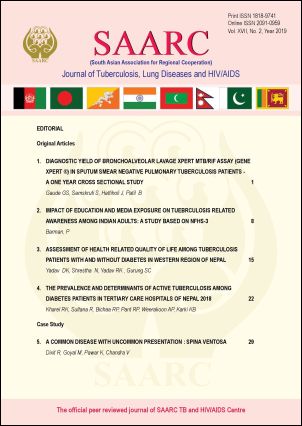Assessment of Health-Related Quality of Life among Tuberculosis Patients with and without Diabetes in Western Region of Nepal
DOI:
https://doi.org/10.3126/saarctb.v17i2.49110Keywords:
Diabetes, Tuberculosis, Quality of Life, Western NepalAbstract
Introduction: Currently Tuberculosis is a great public health importance globally especially in developing countries due to the converging epidemics of communicable diseases. Quality of life is important for people with diabetes and TB and their health care providers for several reasons. Objective of the study was to assess status of quality of life among tuberculosis patients with and without diabetes.
Methods: This research was health facility based cross sectional study and carried out among TB patients registered under directly observed treatment short course therapy and receiving treatment from health facilities of Western Region of Nepal. Interview schedule was used to collect the data. Quality of life was assessed by using Nepali version of WHOQOL-BREFF questionnaires. Data was entered in Epi Data software and analysis was performed with the help of the statistical package for social science version 20.
Results: A total 390 TB patients were participated in this study. The overall prevalence of diabetes mellitus among TB patient was 10.8%. More than half of participants were 15-40 years of age. WHOQOL-BREF measure overall quality of life of TB patients was 68.82±10.79 and it was poor levels of quality of life. Among different socio-demographic variables such as older people, married and illiterate participants had poor QOL than others. HRQoL is affected by age, sex and marital status. TB with diabetes patients had lesser overall quality of life (88.1%) than the TB without diabetes patients (94.4%).
Conclusion: The finding suggests that to improving for TB Patients of Health literacy and counselling are promoted to achieve optimum levels of QOL.
Downloads
Downloads
Published
How to Cite
Issue
Section
License
Copyright © SAARC Tuberculosis and HIV/AIDS Centre (STAC), all rights reserved, no part of this publication may be reproduced, stored in a retrieval system or transmitted in any form or by any means without prior permission of the STAC.





